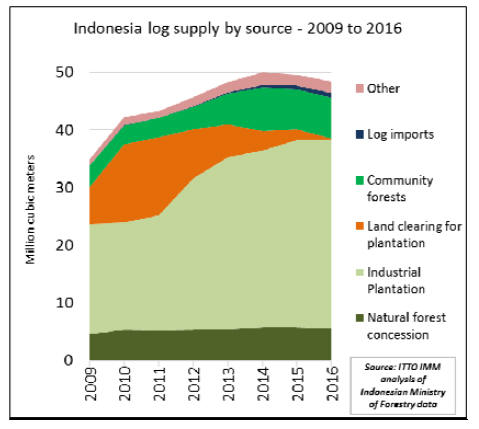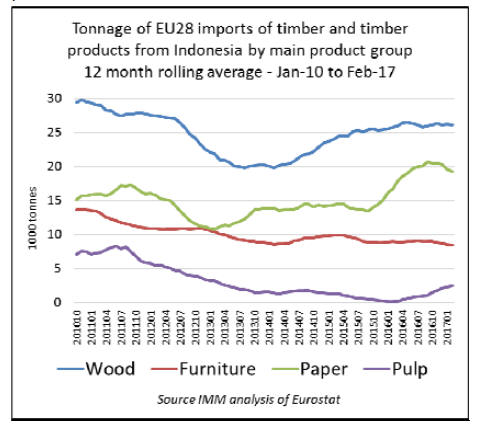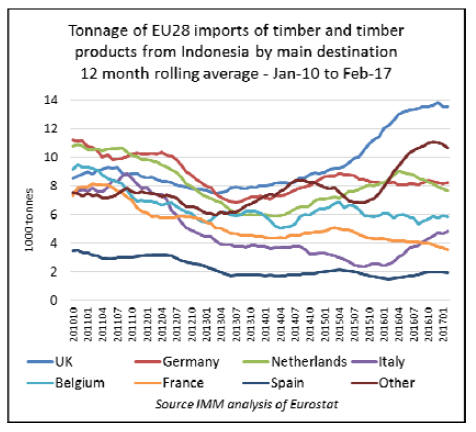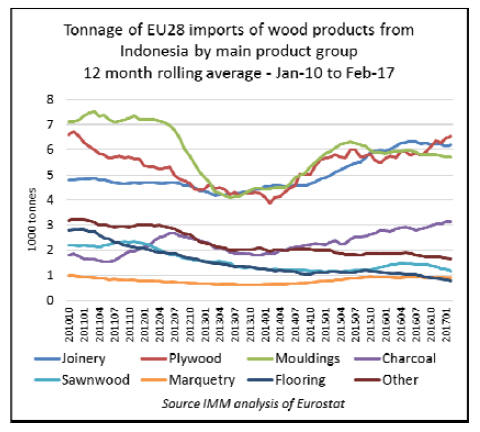|
Report from
Europe
EU trade with Indonesia in the spotlight following
FLEGT licensing
Indonesia issued the first ever FLEGT licenses in mid-
November last year with high expectations that these
would boost the value and share of Indonesia*s wood
exports to the EU.
This is a reasonable expectation, given the very significant
commitment and investment by Indonesia, supported
through the FLEGT Voluntary Partnership Agreement
with the EU, and the mandatory requirement that all
timber and timber products exported from Indonesia to the
EU must now be licensed.
The fact that EU importers no longer need to undertake a
potentially expensive due diligence assessment to
demonstrate EUTR conformance for any timber product of
Indonesian origin should give a significant edge in the
EU*s highly competitive market.
Nor has Indonesia stopped short at imposing a requirement
for exports to the EU. The SVLK certification system on
which FLEGT licensing is based (and which was first
introduced in 2010) is now mandatory for nearly all wood
produced and traded in the country and applies to
industrial plantations (HTI), natural forest concessions
(HPH) and community plantation forests (HTR).
Anecdotal evidence indicates that Indonesia*s SVLK
certificates and FLEGT licenses have been well received
and are at least benefitting some Indonesian suppliers. For
example, the Jakarta Post reported on 17 March that
※many exhibitors at the recent Indonesian International
Furniture Exhibition (IFEX) said the SVLK helped them
increase exports, especially to the EU§.
The news report quotes one Indonesian furniture exporter
as suggesting that ※with the SVLK, buyers from the EU
are more confident about us and we can even sell directly
to them without using traders, and so we enjoy high profit
margins and a market under our own brand§. The increase
in profit margin in this instance was reported to be up to
40% compared to 10% previously.
There is similar anecdotal evidence from European
importers. In an interview published on the Global Timber
Forum website in February this year, a representative of
one of Europe*s largest importers of Indonesian plywood
said that ※arrivals from Indonesia have increased over the
last few weeks as importers and traders are stocking up on
FLEGT licensed material§.
He noted that the FLEGT license has given European
importers more confidence to engage in active promotion
to increase sales of Indonesian plywood and to make more
product available in the market. He added that Indonesia
will have an increasing advantage over time as EU
Competent Authorities are getting stricter and there are
more checks on operators.
These early anecdotal reports are encouraging, but they
refer to isolated cases and the underlying question of the
extent to which FLEGT licensing contributes to real
increases in export share and value remains uncertain.
Relaunch of IMM programme to monitor impact of
FLEGT licensing
This is a question which will be a key focus of the FLEGT
Independent Market Monitoring (IMM) programme which
prepared baseline market research during the period March
2014 to 2016, and which was relaunched on 1 April 2017.
IMM is a multi-year project supervised by ITTO and
financed by the EU to support implementation of VPAs
between the EU and timber supplying countries.
The task of assessing the impact of FLEGT Licensing on
Indonesian trade with the EU and other markets is
complicated by the changing profile of timber product
exports from Indonesia. In Europe, the trade has
traditionally viewed Indonesia primarily as a source of
tropical hardwood plywood and decking.
While these products are still significant, Indonesia has
evolved a very diverse wood manufacturing sector and
supplies the EU with increasingly wide range of more
added value wood products such as furniture, doors and
other joinery.
In 2016, the value of EU imports of joinery products from
Indonesia was close to €75 million and wood furniture
around €300 million. This compares to EU imports of
around €70 million of decking and other mouldings and
€75 million of plywood from Indonesia.
Last year the EU also imported pulp and paper products
from Indonesia with a total value of €225 million.
Although this is only a very small proportion of both EU
and Indonesian trade in pulp and paper, the industry is so
large that this value is comparable to that of wood
products.
If all these products are considered and Brazil is excluded
(since most Brazilian wood product exports now derive
from outside the tropical region), Indonesia is the largest
tropical supplier of forest products to the EU by a
significant margin.
Total EU forest product imports from Indonesia were just
over €1 billion in 2016, up 3% on the previous year. This
compares to EU imports of €816 million from Vietnam
and €550 million from Malaysia (both of which unlike
Indonesia exported less to the EU in 2016). Last year
Indonesia accounted for 24.4% of EU imports wood
products from the tropics (by value), up from 23.8% the
previous year.
Changing profile of Indonesia*s wood product supply
The changing profile of Indonesia in product supply is
closely tied to the changing structure of the resource.
This is evident from data published by the Indonesian
Ministry of Forestry on the source of log supply which
shows that industrial plantations are becoming
increasingly important while the share of supply from
natural forests is falling.
Production from sustainably managed concessions in
natural forest is now stable, but there has been a sharp
decline in forest conversion operations (Chart below).

Last year Indonesia produced 47.5 million m3 of logs of
which 69% derived from industrial plantations (HTI), 15%
from community forests (HTR), 12% from natural forest
concessions (HPH), less than 1% from land clearing, and
4% from a variety of other sources.
This compares to 2009 when log production was 34.8
million m3 of which 55% was from industrial plantations
(HTI), 11% from community forests (HTR), 13% from
natural forest concessions (HPH), 18% from land clearing
operations, and 3% from a variety of other sources.
Another complexity in monitoring market impacts of
FLEGT licensing is that the EU only takes a relatively
small share of Indonesia*s total timber product exports.
The priority attached to the EU in market development,
and the size of flows to the EU, are therefore heavily
dependent on events in other parts of the world.
Data from the Environment and Forestry Ministry show
that total forest product exports through Indonesia*s
legality licensing system were 17.46 million tons with a
value of USD9.27 billion in 2016. Of these exports the EU
accounted for only 4.7% of tonnage and 9.4% of value.
The large majority of Indonesian forest product exports
are destined for other Asian markets (86% of tonnage and
71% of value) while exports to North America are also
significant (4.3% of tonnage and 10.7%) of value.
While the EU has a low share of Indonesia*s total forest
product exports, the data is influenced by the small
proportion of Indonesian pulp and paper destined for the
EU.
In the EU, Indonesia faces very stiff competition from
Brazil in the market for chemical pulp (which derives from
fast-growing plantations of eucalyptus and other hardwood
species) and from domestic European producers in supply
of finished paper products. The majority of Indonesia*s
pulp and paper product exports are destined for China and
other Asian markets.
The EU is relatively more important in Indonesian exports
of some wood products, most notably furniture. Of
Indonesia*s total wood furniture exports of 435,000 tonnes
with a value of USD1.34 billion in 2015, 127,000 tonnes
(29%) with a value of USD319 million (24%) were
destined for the EU.
A preliminary review of prospects for Indonesian wood
products in the EU market due to FLEGT licensing was
provided in a previous ITTO MIS report (16-30 Sept
2017).
This suggested that FLEGT licensing offers an immediate
opportunity for Indonesian suppliers to retake share in
those sectors 每 such as decking, plywood and flooring -
where Indonesian products are familiar to EU importers
and already favoured for their strong technical
performance, but where demand has been dampened by
concerns over the legality of wood supply.
It also suggested that, in isolation, FLEGT licensing is less
likely to generate immediate benefits in those high value
sectors like furniture and joinery where the specific
technical and environmental features of Indonesian wood
products have been less significant barriers to
competitiveness than wider issues such as labour costs, red
tape, logistics, processing efficiency, innovation, and
marketing.
In these sectors, increasing share is only likely to be
achieved if FLEGT licensing is combined with market
development initiatives to improve the international
competitiveness of Indonesian wood manufacturers across
a wider range of issues.
However, the long-term benefits of investment in these
initiatives, alongside FLEGT licensing, would be
considerable given the sheer size of markets for consumer
products like furniture, the relatively high proportion of
Indonesian furniture exports already destined for the EU,
and the greater potential to add value to wood fibre.
Near real坼time monitoring of FLEGT licensed trade
The ITTO FLEGT IMM has been gearing up to test these
various assumptions, as nearly as possible on a real-time
basis.
To provide a taste of the kind of analysis being
undertaken, the following three charts show the evolution
of EU imports from Indonesia, on a monthly basis, in the
7-year period running up to, and immediately following,
the issue of the first FLEGT licenses in November 2016.
These charts establish the baseline against which the
impact of FLEGT licensing on Indonesia*s trade with the
EU trade will be assessed.
Because EU imports from Indonesia tend to be highly
seasonal (furniture imports rise sharply in the run-up to
Christmas and January sales, while decking importers
build stock in the winter months in preparation for the
spring and summer surge in demand), the charts show 12-
month rolling average data to remove short-term
variability and highlight long term trends.
Tonnage data is provided here rather than value data to
remove variations due to very volatile exchange rates
during the period 每 notably the 20% fall in the value of the
euro (and linked currencies like the Polish zloty and
Swedish krona) against the U.S. dollar between 2014 and
2015, and a 30% decline in the value of the British pound
between mid-2014 and the end of 2016 (with a particularly
steep plunge after the Brexit vote in May 2016).

The chart above shows that while pulp and paper have
recently become more important in the mix of products
imported into the EU from Indonesia, imports of wood
products (i.e. those listed in Chapter 44 of the
internationally harmonised HS system of product codes)
are still the largest component.
The data shows that after a period of recovery in 2014 and
2015, EU imports of Chapter 44 wood products from
Indonesia stabilised at the higher level in 2016 (averaging
around 25000 tonnes per month).
While it is sStill very early days there was no immediate
discernible uptick in total EU imports of these products
between December 2016 and February 2017 after the first
licenses were issued.
EU imports of wood furniture from Indonesia were
declining between 2010 and 2013 and then in 2014
showed slight and short-lived signs of recovery. In 2015
and 2016, the decline in imports resumed and continued
through to February 2017.
Trends in pulp and paper imports from Indonesia have
followed a very different path. The EU was importing
small volumes of Indonesian chemical wood pulp before
2013, but these volumes fell to negligible levels in 2014
and 2015, presumably in the face of very stiff competition
from Brazil. However, there were signs of a revival in EU
imports of Indonesian wood pulp from the middle 2016,
although the volumes involved are still very restricted.
EU paper product imports from Indonesia, while still
limited, also recorded a significant uptick in 2016,
averaging below 15,000 tonnes per month at the start of
the year rising to over 20,000 tonnes at the end of 2016.
EU paper imports from Indonesia dipped a little at the start
of this year.

The chart above shows how EU imports of Indonesian
forest products has varied in different EU member states
over the last seven years.
Following a surge in imports between 2014 and 2016, the
UK has emerged as by far the largest single importer in the
EU 每 which highlights the significance of imminent Brexit
negotiations on the future direction of policy in relation to
FLEGT licensing.
The recent surge in UK imports from Indonesia has been
distributed across a range of product groups including
paper, plywood, and wooden doors and furniture.

﹛
Another notable trend in the Chart is the recent sharp rise
in imports by Italy and a range of ※other§ EU countries not
previously significant importers of Indonesian forest
products.
Italy has emerged as the leading destination for EU
imports of Indonesian wood pulp in the last two years, and
is also importing a small but rising volume of Indonesian
paper products. The ※other§ EU countries now importing
more from Indonesia are also mainly trading in Indonesian
paper products and all are in South-Eastern Europe 每
Slovenia, Romania, Hungary, and Greece.
The chart left focuses in on trends in EU imports of HS
Chapter 44 wood products from Indonesia. It shows that
EU imports of Indonesian joinery products (mainly doors),
mouldings (mainly external decking) and plywood all
increased in 2014 and 2015, before stabilising and
converging at around the same level of 6000 tonnes per
month throughout 2016.
Of these products, only plywood registered an uptick in
early 2017 lending some early statistical support to
anecdotal evidence of EU importers stocking up
immediately following issue of the first licenses.
Notable trends in other product groups are the progressive
rise in EU imports of charcoal from Indonesia 每 a product
which incidentally is excluded from both the FLEGT
licensing requirements in Indonesia and the due diligence
requirements of the EUTR 每 and the continued slide EU
imports of Indonesian wood flooring to negligible levels.
In coming months, IMM will look closely at the evolution
of all these trade flows, comparing the flows with those of
competing products, while also monitoring underlying
economic conditions, and factors such as exchange and
freight rates with an important bearing on relative
competitiveness.
The statistical analysis of trade data will be supported by a
network of IMM correspondents which are currently being
recruited to liaise with relevant authorities and keep track
of important developments on the supply side in Indonesia
and other VPA Partner countries They will undertake
market assessment interviews with traders and other
interests in seven EU countries which together account for
over 90% of all imports of wood products from VPA
partner countries into the EU (Belgium, France, Germany,
Italy, Netherlands, Spain and the UK).
ETTF forecasts stability in European tropical wood
trade in 2017
The European Timber Trade Federation's latest newsletter
includes a commentary on the tropical hardwood trade in
Europe by Armand Stockmans, Director of Belgium-based
Somex Wood Import.
Stockmans suggests there will be no seismic trends this
year, although there are concerns beyond trading factors,
such as the extent to which FLEGT-licensed timber will
impact demand for certified sustainable timber.
According to Stockmans, while 2016 ended with a
slowdown, and individual markets are showing a range of
trends, overall indicators point to general stability.
France, for instance, remains difficult. Prices and volumes
are low and turnover decreasing.
However, the Netherlands is picking up with timber and
construction sectors ahead nearly 9.5% in the last three
months. Initial 2016 growth in Belgium petered out in the
second half. But currently the situation looks stable.
Meanwhile, Spain is in better mood and consumption is
increasing.
The supply side looks reasonably calm, says Stockmans,
with availability and price trending static or down for
some species, but up for others. Asian demand is picking
up again in Africa and some species like Tali and Azobe
logs are difficult to get.
However, Sipo prices are level and Iroko is rising, but
slowly. FSC Ayous is scarce and demand is strong. But
Padouk availability has improved, thanks to lower demand
from China and India. In fact shortage turned into a
surplus, although, with strong Belgian consumption and
Asian buyers returning, this could evaporate.
Stockmans observed that sapele prices are up again too;
5% generally, and 10% for fixed sizes. The basis of this
though is the positive Dutch market, which is moving
increasingly to finger-jointed product in sapele and
meranti.
After increases in heavier variants Nemesu and Bukit,
Meranti prices have plateaued at a higher level. Suppliers
of Brazilian decking also upped prices, which buyers,
mainly in France, refused to pay. Once existing stock is
exhausted, however, Stockmans expects that these
increases will feed through.
Stockmans also notes demand increases for finger-jointed
laminates in all European countries 每 presenting an
opening for using lesser known species.
Stockmans believes that the arrival of the first FLEGTlicensed
timber from Indonesia is positive overall but also
suggested that availability of FLEGT-licensed timber
could lead buyers and suppliers settling for legally assured
only and not progressing to FSC or PEFC-certified
material.
Stockmans observes that "in Africa we*re already hearing
&Our FLEGT VPA will soon be implemented, we don*t
need to do anything until then* - to minimise these risks,
while welcoming FLEGT-licensing, the trade should
emphasise that our goal is legality and sustainability."
The ETTF newsletter is available at:
http://www.ettf.info/sites/ettf/files/ETTF%20Newsletter%20Win
ter-Spring%202017.pdf
EU slaps antidumping duty on Chinese plywood
In an official release dated 5 April 2017 the European
Commission has imposed an anti-dumping duty on EU
imports of okoum谷 plywood (CN 4412311010) originating
in China.
The product is defined as follows: plywood consisting
solely of sheets of wood, each ply not exceeding 6 mm
thickness, with at least one outer ply of okoum谷 not coated
by a permanent film of other materials, originating in the
PRC, currently falling within CN code ex 4412 31 10
(TARIC code 4412 31 10 10)
The decision comes after the European Timber Trade
Federation lodged a complaint asking for an investigation
on pricing of plywood from China.
Representatives of more than 25% of the total EU
producers of okoum谷 plywood complained that Chinese
plywood is being sold at a very low price.
For the full details see: http://eur-lex.europa.eu/legalcontent/
EN/TXT/?qid=1493369751449&uri=CELEX:32017R06
48
|